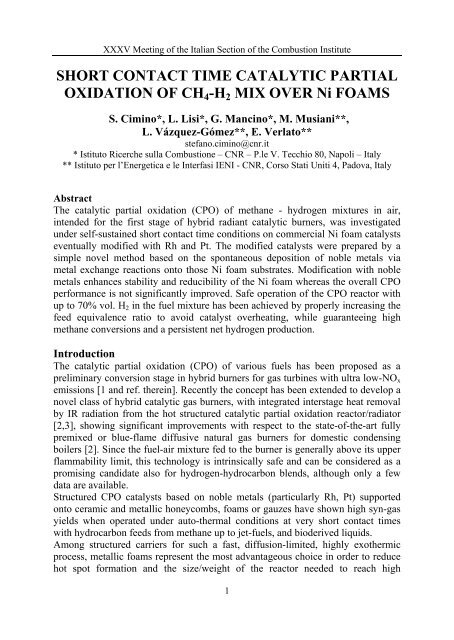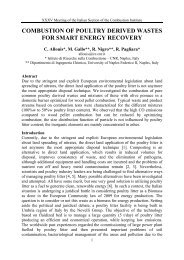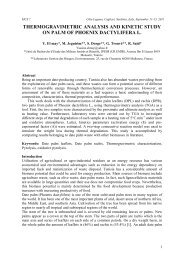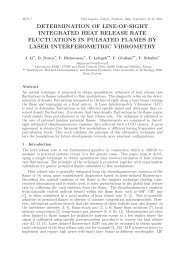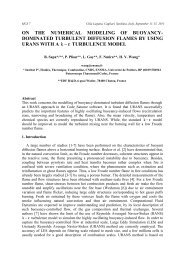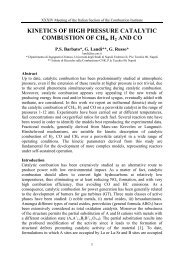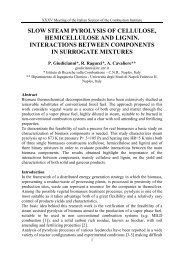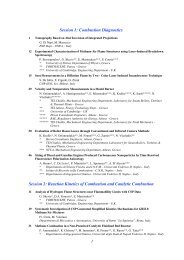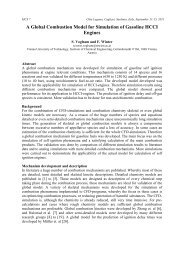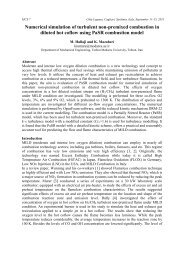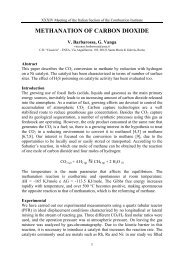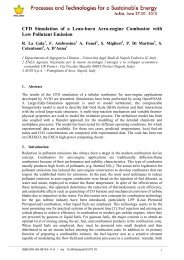SHORT CONTACT TIME CATALYTIC PARTIAL OXIDATION OF CH4 ...
SHORT CONTACT TIME CATALYTIC PARTIAL OXIDATION OF CH4 ...
SHORT CONTACT TIME CATALYTIC PARTIAL OXIDATION OF CH4 ...
Create successful ePaper yourself
Turn your PDF publications into a flip-book with our unique Google optimized e-Paper software.
XXXV Meeting of the Italian Section of the Combustion Institute<br />
<strong>SHORT</strong> <strong>CONTACT</strong> <strong>TIME</strong> <strong>CATALYTIC</strong> <strong>PARTIAL</strong><br />
<strong>OXIDATION</strong> <strong>OF</strong> CH 4 -H 2 MIX OVER Ni FOAMS<br />
S. Cimino*, L. Lisi*, G. Mancino*, M. Musiani**,<br />
L. Vázquez-Gómez**, E. Verlato**<br />
stefano.cimino@cnr.it<br />
* Istituto Ricerche sulla Combustione – CNR – P.le V. Tecchio 80, Napoli – Italy<br />
** Istituto per l’Energetica e le Interfasi IENI - CNR, Corso Stati Uniti 4, Padova, Italy<br />
Abstract<br />
The catalytic partial oxidation (CPO) of methane - hydrogen mixtures in air,<br />
intended for the first stage of hybrid radiant catalytic burners, was investigated<br />
under self-sustained short contact time conditions on commercial Ni foam catalysts<br />
eventually modified with Rh and Pt. The modified catalysts were prepared by a<br />
simple novel method based on the spontaneous deposition of noble metals via<br />
metal exchange reactions onto those Ni foam substrates. Modification with noble<br />
metals enhances stability and reducibility of the Ni foam whereas the overall CPO<br />
performance is not significantly improved. Safe operation of the CPO reactor with<br />
up to 70% vol. H 2 in the fuel mixture has been achieved by properly increasing the<br />
feed equivalence ratio to avoid catalyst overheating, while guaranteeing high<br />
methane conversions and a persistent net hydrogen production.<br />
Introduction<br />
The catalytic partial oxidation (CPO) of various fuels has been proposed as a<br />
preliminary conversion stage in hybrid burners for gas turbines with ultra low-NO x<br />
emissions [1 and ref. therein]. Recently the concept has been extended to develop a<br />
novel class of hybrid catalytic gas burners, with integrated interstage heat removal<br />
by IR radiation from the hot structured catalytic partial oxidation reactor/radiator<br />
[2,3], showing significant improvements with respect to the state-of-the-art fully<br />
premixed or blue-flame diffusive natural gas burners for domestic condensing<br />
boilers [2]. Since the fuel-air mixture fed to the burner is generally above its upper<br />
flammability limit, this technology is intrinsically safe and can be considered as a<br />
promising candidate also for hydrogen-hydrocarbon blends, although only a few<br />
data are available.<br />
Structured CPO catalysts based on noble metals (particularly Rh, Pt) supported<br />
onto ceramic and metallic honeycombs, foams or gauzes have shown high syn-gas<br />
yields when operated under auto-thermal conditions at very short contact times<br />
with hydrocarbon feeds from methane up to jet-fuels, and bioderived liquids.<br />
Among structured carriers for such a fast, diffusion-limited, highly exothermic<br />
process, metallic foams represent the most advantageous choice in order to reduce<br />
hot spot formation and the size/weight of the reactor needed to reach high<br />
1
XXXV Meeting of the Italian Section of the Combustion Institute<br />
conversions for their outstanding gas-to-solid heat- and mass-transfer<br />
characteristics and high specific geometric surface areas.<br />
Metallic foams are generally used as support structures for high-surface-area<br />
ceramic supports [4,5] such as γ-Al 2 O 3 which are used to disperse the active metal<br />
phase. However the deposition of a thin uniform washcoat layer of refractory<br />
oxides firmly anchored to the metal struts is not a trivial matter, but is of<br />
paramount importance in order to guarantee long catalyst durability. On the other<br />
hand metallic foam/gauze itself can be made of an active catalytic element as for<br />
the case of copper, nickel and their alloys as well as noble metals.<br />
In the present paper, we set out to investigate for the first time the catalytic partial<br />
oxidation of methane - hydrogen mixtures with air over metallic Ni foam catalysts<br />
intended as the first conversion stage in radiant hybrid catalytic burners and<br />
operated under self-sustained high temperature, short contact time conditions.<br />
Experimental<br />
Ni, Pt-Ni and Rh-Ni catalysts were produced using as substrates Ni foam discs<br />
(with a 18 mm diameter) cut from grade 50 INC<strong>OF</strong>OAM TM sheets 0.17 cm thick.<br />
The apparent density of the foam was 0.22 g cm -3 , corresponding to a void volume<br />
fraction of 0.975, an average pore size of ca. 500 μm and strut diameter of ca. 60<br />
μm. The preparation of modified catalysts, was performed via the spontaneous<br />
deposition of noble metals (Pt or Rh) onto those Ni foam substrates, obtained<br />
through the direct immersion of the foam in a solution of complex noble metal ions<br />
(PtCl 6 2- or RhCl 6 3- ) at controlled time and pH. The noble metal loadings in Pt-Ni<br />
and Rh-Ni catalysts employed for the CPO tests were respectively 0.68 % and 0.26<br />
% w./w.<br />
Catalytic Partial Oxidation tests were performed with two identical catalytic discs<br />
(d=18mm, total length 1.7 × 2 = 3.4mm), stacked between two mullite foam<br />
monoliths (45 ppi, L=12mm) as heat shields, and fitted with ceramic paper in a<br />
quartz tube reactor (I.D.= 20mm) which was inserted in an electric furnace. Highpurity<br />
gases (CH 4 , O 2 , N 2 , H 2 ) calibrated via mass-flow controllers, were premixed<br />
and fed to the reactor at a gas hourly space velocity (GHSV) comprised<br />
between 1.1 to 3.4 ×10 5 h -1 corresponding to a minimum contact time (based on the<br />
solid volume of the foam) of 0.27 ms at standard conditions. Catalytic partial<br />
oxidation tests were run under self-sustained high temperature conditions at fixed<br />
preheating (200°C) and an overall pressure of P=1.1 bar, using simulated air as the<br />
oxidant. In view of the partial substitution of methane with hydrogen in a hybrid<br />
combustion device, CPO tests with CH 4 -H 2 mixtures with variable H 2 contents<br />
(yH 2 up to 70% vol. of the fuel) were run at fixed nominal power and equivalence<br />
ratio of the feed (φ = 3.2, 3.6, 4.0 always above the upper flammability limit for the<br />
fuel mix in air at room conditions).<br />
2
XXXV Meeting of the Italian Section of the Combustion Institute<br />
Results and Discussion<br />
SEM images of Pt-Ni and Rh-Ni catalysts show that, besides some 100-nm nuclei<br />
of noble metals, the surface is rather homogeneously covered by much smaller<br />
needle-like crystals. Since SEM analysis do not allow to quantitatively assess the<br />
relative size of Pt and Rh nanocrystals, electrochemical methods were employed to<br />
determine the noble metal surface area [6]. For comparable loadings, the Rh<br />
deposits have larger surface areas and smaller dimensions than the Pt deposits. The<br />
typical specific surface area per unit noble metal mass in the Pt-Ni and Rh-Ni foam<br />
samples used for CPO tests were respectively 3 and 40 m 2 g -1 .<br />
Figure 2. SEM images of a Pt-Ni catalyst (left) and a Rh-Ni catalyst (right).<br />
Ni foam based catalysts showed a remarkable activity for the catalytic partial<br />
oxidation of pure methane. Our experiments were run under self-sustained high<br />
temperature conditions (>800°C), with limited preheating (200°C) and very short<br />
contact times, always giving complete O 2 conversion, and high selectivities to CO<br />
and H 2 . After an initial stabilization, which was shorter for doped catalysts, the<br />
methane CPO performance curves of Rh-Ni, Pt-Ni and unmodified Ni foam<br />
catalysts were superimposed within experimental accuracy. In particular methane<br />
conversion, and selectivities to CO and H 2 followed the trends of adiabatic<br />
equilibrium calculated excluding solid carbon formation, departing from them due<br />
to heat losses from the hot catalytic foam that enhanced the kinetic limitation of the<br />
steam reforming reaction path. On the other hand, the water gas shift reaction<br />
always proceeded fast enough to closely approach its equilibrium at the exit gas<br />
temperature, even at the shortest contact times tested. In general the thermal<br />
efficiency of the lab-scale reactor, estimated comparing the temperatures recorded<br />
in the gas leaving the catalytic stage with the corresponding temperature calculated<br />
from the actual composition of the product stream assuming adiabatic conditions<br />
[7], varied between 0.78 and 0.85. It should be considered that testing under nonadiabatic<br />
conditions is required in view of the use of structured CPO reactors as<br />
radiant elements in hybrid catalytic burners, where a large fraction of the nominal<br />
input power can be transferred by direct IR-radiation from the hot catalyst [2,3].<br />
3
XXXV Meeting of the Italian Section of the Combustion Institute<br />
CPO experiments with methane-hydrogen mixture were run by increasing the H 2<br />
content in the fuel blend, at fixed equivalence ratio and nominal input power:<br />
steady state catalytic performances for the unmodified Ni foam and for Pt- or Rhmodified<br />
catalysts were almost identical, as shown in Fig. 2 a-d for the case of φ=4.<br />
The partial substitution of methane with H 2 caused a progressive increase of the<br />
temperature of the catalytic foams (in Fig. 3a for Pt-Ni catalyst) and of the product<br />
syn-gas, in agreement with the trend of the adiabatic equilibrium temperature (Fig.<br />
2a), that increases because of the higher heat of combustion of H 2 per mole of<br />
oxygen [8] and the lack of endothermic chemistry with respect to methane.<br />
Methane conversion (Fig. 2b) increased progressively with increasing the hydrogen<br />
content in the fuel mix, due to higher temperatures on the catalyst and higher<br />
partial pressures of water speeding up the kinetically limited steam reforming<br />
reaction. CO selectivity (Fig 2c) raised slightly approaching the equilibrium value<br />
for the highest hydrogen contents.<br />
T g<br />
out °C<br />
CH 4<br />
conversion %<br />
1100<br />
1000<br />
900<br />
800<br />
700<br />
100<br />
90<br />
80<br />
70<br />
60<br />
50<br />
0.0 0.2 0.4 0.6 0.8<br />
y H 2<br />
fuel<br />
0.0 0.2 0.4 0.6 0.8<br />
y H 2<br />
fuel<br />
Ni<br />
Rh-Ni<br />
Pt-Ni<br />
4<br />
CO selectivity %<br />
H 2<br />
out /O 2<br />
in<br />
100<br />
90<br />
80<br />
70<br />
60<br />
50<br />
5<br />
4<br />
3<br />
2<br />
1<br />
0<br />
0.0 0.2 0.4 0.6 0.8<br />
y H 2<br />
fuel<br />
0 1 2 3<br />
H 2<br />
in /O 2<br />
in<br />
Figure 2. Effect of the H 2 content in CH 4 -H 2 fuel blends during the CPO in air at<br />
fixed input power (0.38 kW) and equivalence ratio φ (4.0) over pure Ni foam, Rhand<br />
Pt-modified catalysts: a) temperature of the gas leaving the catalyst, b) CO<br />
selectivity, and c) methane conversion as a function of yH 2 ; d) hydrogen<br />
production expressed as H 2 out /O 2 in vs. H 2 in /O 2 in . Dashed lines represent<br />
thermodynamic equilibrium values (p, H=constant).<br />
Fig. 3a,b illustrate the qualitative analogy in the trends of methane conversion and<br />
surface temperatures observed at three levels of the feed equivalence ratio as a<br />
function of yH 2 in the fuel. As expected, lower values of φ, corresponding to<br />
higher quantities of oxygen (the limiting reactant) in the feed, were responsible for
XXXV Meeting of the Italian Section of the Combustion Institute<br />
higher methane conversions and catalyst temperatures; this circumstance imposed a<br />
progressive reduction in the maximum value of yH 2 to avoid catalyst overheating.<br />
In other words, fuel mixtures very rich in H 2 or even pure hydrogen can be safely<br />
handled in a hybrid catalytic burner by increasing the feed equivalence ratio, whose<br />
minimum allowable value, set by the thermal resistance of the catalyst, will depend<br />
directly on the efficiency of heat removal from the CPO reactor [2,3].<br />
Tcat in °C<br />
1100<br />
1050<br />
1000<br />
950<br />
900<br />
850<br />
800<br />
100<br />
0.0 0.2 0.4 0.6 0.8<br />
y H 2 fuel<br />
φ =4.0<br />
φ =3.6<br />
φ =3.2<br />
CH 4<br />
conversion %<br />
5<br />
100<br />
90<br />
80<br />
70<br />
60<br />
50<br />
0.0 0.2 0.4 0.6 0.8<br />
y H 2<br />
fuel<br />
0.0 0.2 0.4 0.6 0.8<br />
y H 2 fuel<br />
Figure 3. Effect of the H 2 content in CH 4 -H 2 fuel blends during the CPO in air over<br />
Pt-Ni foam catalyst at three levels of feed equivalence ratio φ (4.0, 3.6, 3.2): a)<br />
temperature on the front face of the catalyst, b) methane conversion.<br />
A net hydrogen production was observed across the CPO reactor for all the inlet<br />
compositions explored: as seen in Fig. 2d more H 2 was produced than fed up to an<br />
inlet H 2 /O 2 ratio of 3. The progressive substitution of CH 4 with H 2 shifted the<br />
process O-selectivity towards H 2 O rather than CO and CO 2 , with a distribution<br />
among the three oxygenated products which was rather unaffected by the specific<br />
level of the inlet equivalence ratio φ. In fact the WGS reaction reached equilibrium<br />
on all the three catalysts even with the addition of large quantities of H 2 in the feed.<br />
In spite of the lack of experimental data for CH 4 -H 2 mixtures, several literature<br />
reports have shown the effectiveness of H 2 as sacrificial fuel in the CPO of ethane<br />
over Pt- based structured catalysts to boost ethylene production via homogeneous<br />
oxycracking of C 2 H 6 [8,9 and ref. therein]. In particular it was found that H 2 is<br />
rapidly and preferentially oxidized instead of ethane in the first part of the catalytic<br />
reactor due to its higher reactivity with respect to the hydrocarbon, causing a<br />
marked increase in the catalyst temperature in this zone [9]. Further downstream<br />
the reactor H 2 is produced again via ethane dehydrogenation and steam reforming<br />
[9]. Apart from the obvious lack of homogeneous oxy-dehydrogenation chemistry,<br />
a similar mechanism can be argued also for hydrogen addition to methane on Nibased<br />
foam catalysts, also in view of the lower reactivity of methane with respect<br />
to ethane.<br />
Although the contribution from the homogeneous combustion of H 2 cannot be<br />
excluded from the present data of integral CPO reactor performance, flashback and<br />
ignition of the fuel-air mixture upstream of the catalyst were never observed even
XXXV Meeting of the Italian Section of the Combustion Institute<br />
at the highest hydrogen contents because of the high values of the feed equivalence<br />
ratio.<br />
References<br />
[1] Bairda B, Etemad S, Karim H, Alavandi S, Pfefferle W. Gas turbine engine<br />
test of RCL catalytic pilot for ultra-low NOx applications. Catal. Today 155:<br />
13-17 (2010).<br />
[2] Cimino S., Russo G., C. Accordini, G. Toniato, “Development of a hybrid<br />
catalytic burner”, Combust. Sci. Tech. 182: 380-391 (2010).<br />
[3] Cimino S., Allouis C., Pagliara R., Russo G., ”Effect of catalyst formulation<br />
on the performance of a natural gas hybrid catalytic burner”, Catal. Today<br />
171: 72-78 (2011).<br />
[4] Giani L, Groppi G, Tronconi E. Mass-transfer characterization of metallic<br />
foams as supports for structured catalysts. Ind Eng Chem Res 44(14):4993–<br />
5002 (2005)<br />
[5] Coleman L, Croiset E, Epling W, Fowler M, Hudgins R. Evaluation of Foam<br />
Nickel for the Catalytic Partial Oxidation of Methane. Catal Lett 128: 144<br />
(2009)<br />
[6] Verlato E, Cattarin S, Comisso N, Gambirasi A, Musiani M, Vázquez-<br />
Gómez L. Preparation of Pd-modified Ni Foam Electrodes and their Use as<br />
Anodes for the Oxidation of Alcohols in Basic Media. Electrocatalysis 3:<br />
48-58 (2012)<br />
[7] Beretta A, Groppi G, Lualdi M, Tavazzi I, Forzatti P. Experimental and<br />
modelling analysis of methane partial oxidation: transient and steady state<br />
behavior of Rh-coated honeycomb monoliths. Ind Eng Chem Res 48: 3825-<br />
3836 (2009).<br />
[8] Cimino S, Donsì F, Russo G, Sanfilippo D. Olefins production by catalytic<br />
partial oxidation of ethane and propane over Pt/LaMnO3 catalyst. Catal<br />
Today 157: 310-314 (2010).<br />
[9] Michael BC, Nare DN, Schmidt LD. Catalytic partial oxidation of ethane to<br />
ethylene and syngas over Rh and Pt coated monoliths: Spatial profiles of<br />
temperature and composition. Chem Eng Sci 65: 3893-3902 (2010).<br />
10.4405/35proci2012.V4<br />
6


